Last Updated on December 29, 2021 at 6:14 pm
Suresh Padmanaban writes, “Dear Pattu, I have been investing in the markets since the mid-90s. I get a feeling that the volatility over these years has gradually come down. Can you please quantitatively verify this?” On 3rdf Feb 2021, the Sensex closed above 50,000 for the first time. We studied the evolution of stock market volatility over the last 42 years and found that the cumulative volatility has gradually come down for the Sensex.
Cumulative volatility is the standard deviation of daily returns over time. The maximum volatility for the Indian markets was around the Harshad Mehta scam (early 1990’s) and for the US markets during the great depression (1930’s). Since then the daily volatility has indeed been gradually decreasing as Suresh suspected.
For the US, the standard deviation in monthly prices calculated every possible 10 years peaked during the 1930s but has been more or less the same then! This is quite remarkable and counterintuitive when you stop and think about it. In India, we barely have enough historical data. The five-year rolling volatility has decreases constantly. The Harshed Mehta crash was the highest, the dot com crash was much lower and the 2008 crash in between. The March 2020 crash was a mere blip for the US markets and significantly lower for the Sensex. The full report is available here: Sensex at 50,000 – lessons from the 42-year journey
In this article, we shall approach the titular question from a different angle. We shall consider a systematic monthly investment over 15 years into an asset allocation of either 70% equity or 50% equity and the rest in debt.
Join 32,000+ readers and get free money management solutions delivered to your inbox! Subscribe to get posts via email! (Link takes you to our email sign-up form)
🔥Want to create a complete financial plan? Learn goal-based investing? Exclusive access to our DIY tools? Increase your income with your skills? Enjoy massive discounts on our robo-advisory tool & courses! 🔥
The NSE 500 TRI will represent “equity” and the I-BEX gilt index will represent “debt”. The portfolio will be rebalanced once every 12 months. We will consider 137 15-year periods from Jan 1995 to May 2021. Please note, this is just a smattering of data and one should not rush to conclusions based on this. A similar study performed with the US markets would yield ten times more data! See: This “buy high, sell low” market timing strategy surprisingly works!
The results for 70% equity and 50% equity are presented below.
- Top left: The XIRR (annualized return) for the 137 runs are shown
- Top right: The max fall from an all-time high (of the portfolio value)
For example, shown below is one of the 137 runs (the most recent one). The fall from the peak is shown on the right (drawdown). The max drawdown (or the longest stalactite) is selected from this.
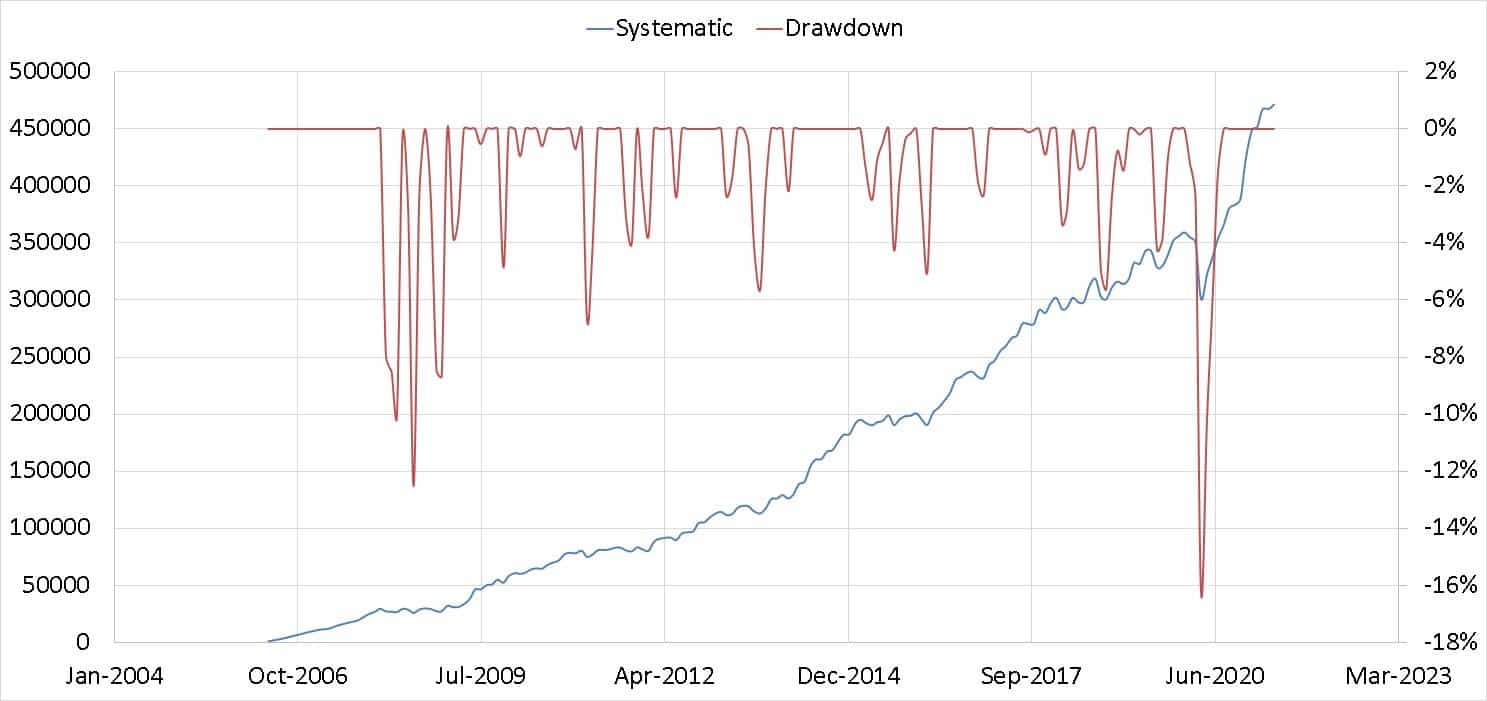
- Bottom left: The standard deviation of the monthly change in portfolio value. The monthly returns for one of the runs are shown below.
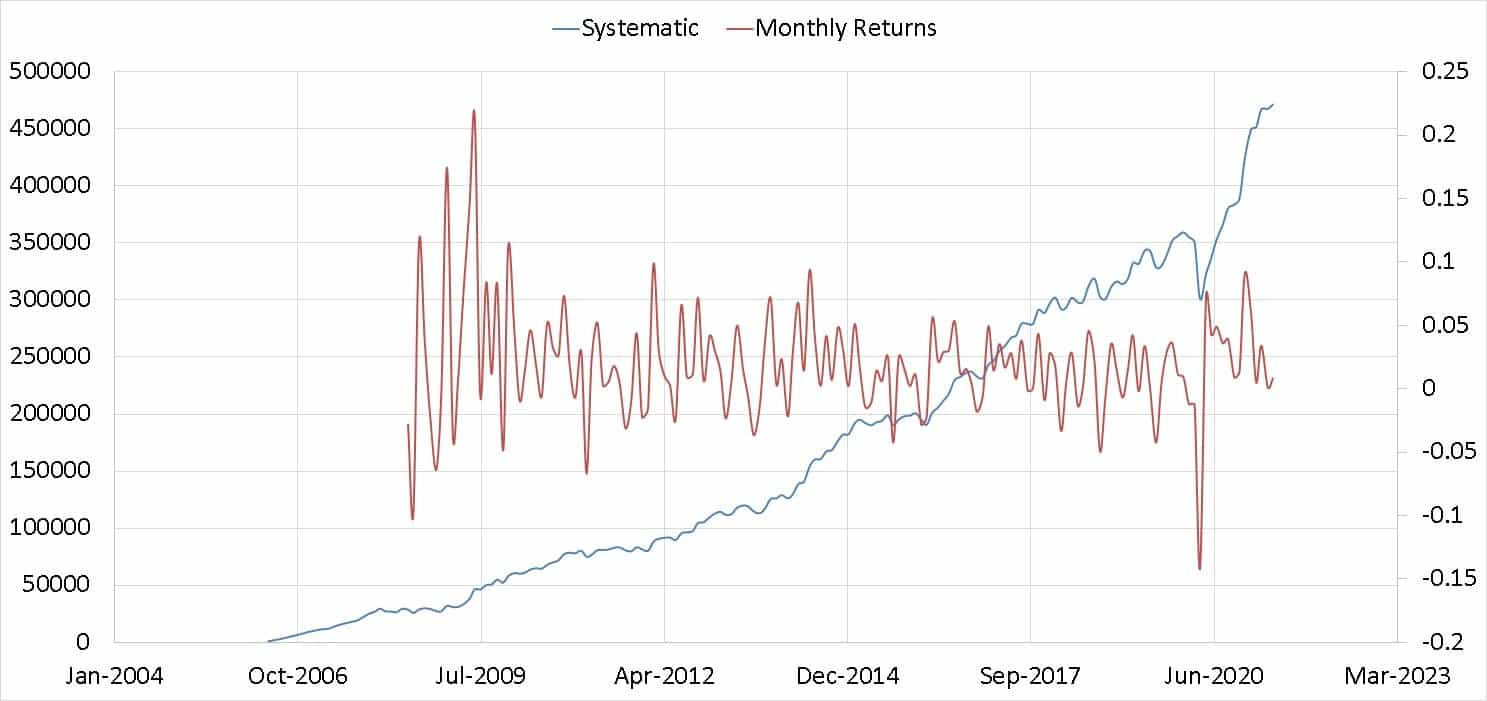
- Bottom right: The no of continuous months the portfolio was below its previous maximum. This corresponds to the widest drawdown stalactite.
The results are compiled below. We recommend that readers inspect the graph for a bit to appreciate the results.
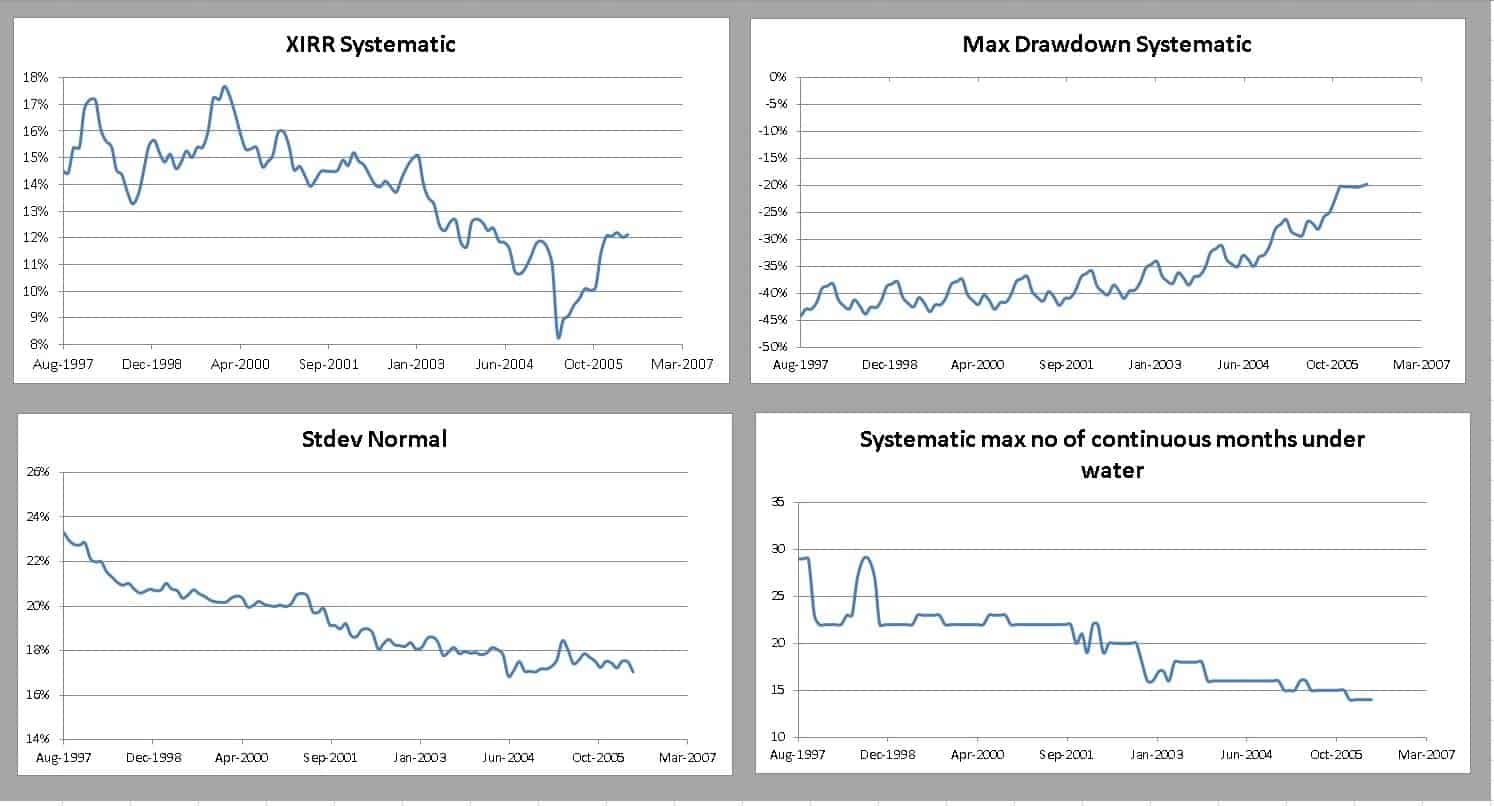
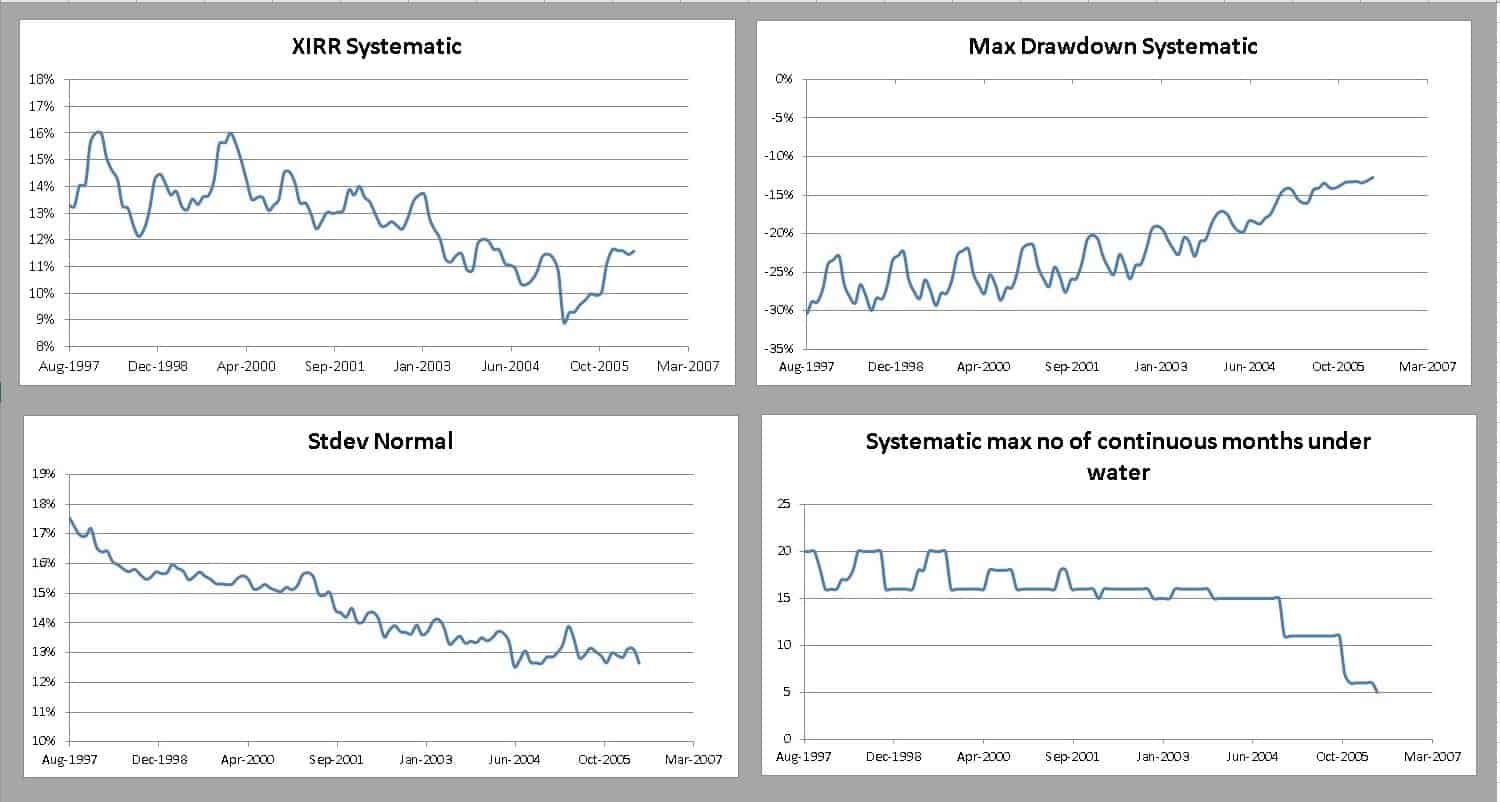
For the period studied, XIRR (annualized returns) has decreased. See: What return can I expect from a Nifty 50 SIP over the next 10 years? And Do not expect double-digit returns from Nifty Next 50 index funds!
The volatility has decreased, the drawdowns have decreased (become less negative) and the number of months the portfolio was underwater has decreased. The wave-like pattern in the lines is because of rebalancing. We shall update the effect of not rebalancing in a future article. This has been studied before: When should I rebalance my portfolio?
So what does this mean? Suresh is right. Equity investing has got a little “easier” over the last two decades. However, this does not mean it would get even easier in future or the volatility would stabile (become range-bound) like in the US. So it would be better to imagine that the Indian stock market has “stabilized” since the 90s with domestic institutional support rather than become easier. Our market history is too short to make inferences.
We shall conclude with the updated chart for US data (details of the study are linked above) for comparison.
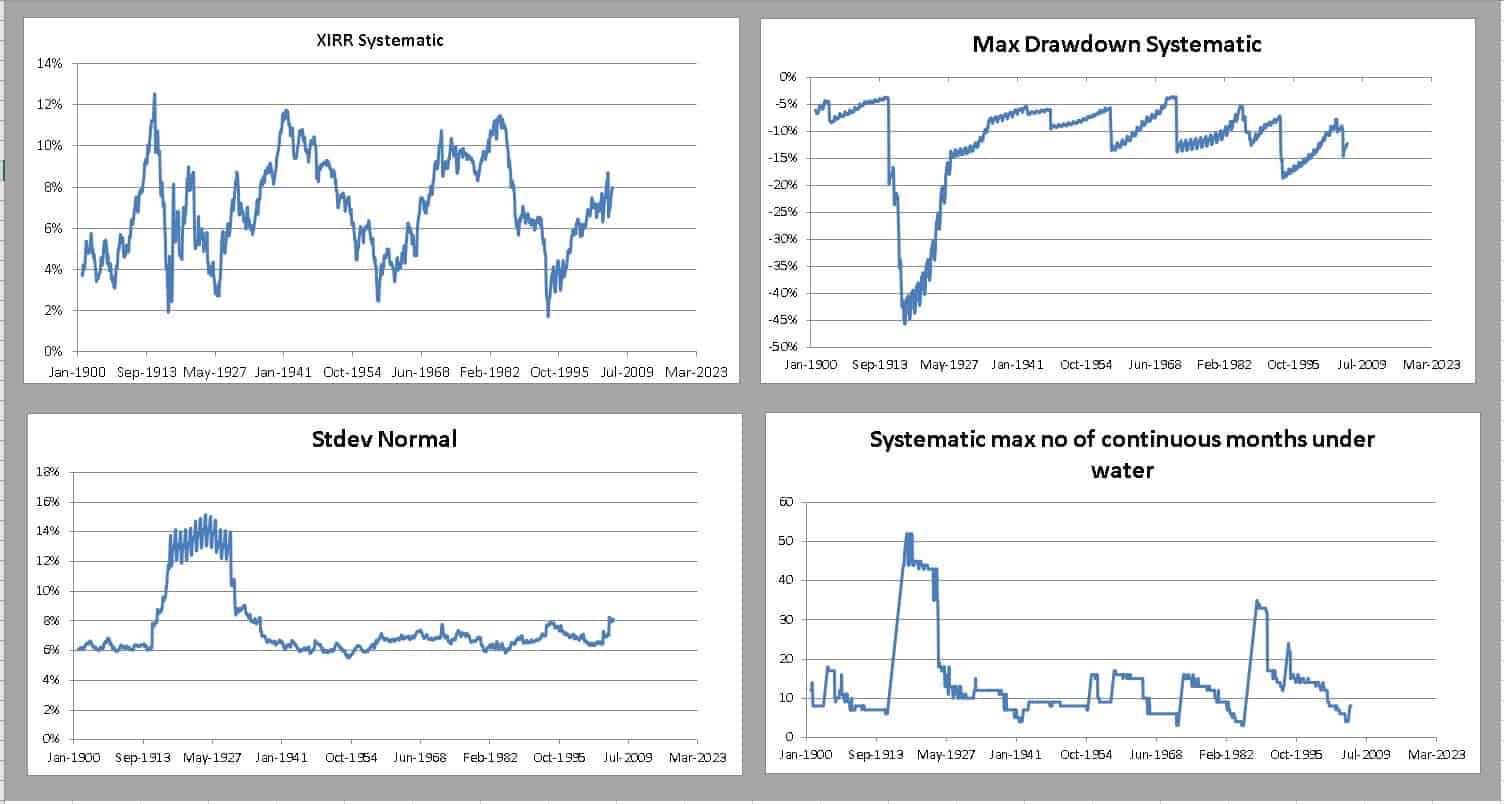
Notice the cyclic nature of the returns. The Indian market has possibly seen just one arm of a cycle. Notice the strong dominance of the 1929 stock market crash in the volatility graphs. The volatility is range-bound (at least relative to the great depression years) and the returns have always been cyclic.
What return should an investor in the US market expect over the next 15 years? The honest answer, “no one knows” (even if we assume over 15 years USD-IND returns would be about 4-5%). See: Motilal Oswal S&P 500 Index Fund: What return can I expect from this? And Do not expect returns from mutual fund SIPs! Do this instead!
🔥Enjoy massive discounts on our courses, robo-advisory tool and exclusive investor circle! 🔥& join our community of 7000+ users!
Use our Robo-advisory Tool for a start-to-finish financial plan! ⇐ More than 2,500 investors and advisors use this!
Track your mutual funds and stock investments with this Google Sheet!
We also publish monthly equity mutual funds, debt and hybrid mutual funds, index funds and ETF screeners and momentum, low-volatility stock screeners.





- Do you have a comment about the above article? Reach out to us on Twitter: @freefincal or @pattufreefincal
- Have a question? Subscribe to our newsletter using the form below.
- Hit 'reply' to any email from us! We do not offer personalized investment advice. We can write a detailed article without mentioning your name if you have a generic question.
Join 32,000+ readers and get free money management solutions delivered to your inbox! Subscribe to get posts via email! (Link takes you to our email sign-up form)
About The Author
 Dr M. Pattabiraman(PhD) is the founder, managing editor and primary author of freefincal. He is an associate professor at the Indian Institute of Technology, Madras. He has over ten years of experience publishing news analysis, research and financial product development. Connect with him via Twitter(X), Linkedin, or YouTube. Pattabiraman has co-authored three print books: (1) You can be rich too with goal-based investing (CNBC TV18) for DIY investors. (2) Gamechanger for young earners. (3) Chinchu Gets a Superpower! for kids. He has also written seven other free e-books on various money management topics. He is a patron and co-founder of “Fee-only India,” an organisation promoting unbiased, commission-free investment advice.
Dr M. Pattabiraman(PhD) is the founder, managing editor and primary author of freefincal. He is an associate professor at the Indian Institute of Technology, Madras. He has over ten years of experience publishing news analysis, research and financial product development. Connect with him via Twitter(X), Linkedin, or YouTube. Pattabiraman has co-authored three print books: (1) You can be rich too with goal-based investing (CNBC TV18) for DIY investors. (2) Gamechanger for young earners. (3) Chinchu Gets a Superpower! for kids. He has also written seven other free e-books on various money management topics. He is a patron and co-founder of “Fee-only India,” an organisation promoting unbiased, commission-free investment advice.Our flagship course! Learn to manage your portfolio like a pro to achieve your goals regardless of market conditions! ⇐ More than 3,000 investors and advisors are part of our exclusive community! Get clarity on how to plan for your goals and achieve the necessary corpus no matter the market condition is!! Watch the first lecture for free! One-time payment! No recurring fees! Life-long access to videos! Reduce fear, uncertainty and doubt while investing! Learn how to plan for your goals before and after retirement with confidence.
Our new course! Increase your income by getting people to pay for your skills! ⇐ More than 700 salaried employees, entrepreneurs and financial advisors are part of our exclusive community! Learn how to get people to pay for your skills! Whether you are a professional or small business owner who wants more clients via online visibility or a salaried person wanting a side income or passive income, we will show you how to achieve this by showcasing your skills and building a community that trusts and pays you! (watch 1st lecture for free). One-time payment! No recurring fees! Life-long access to videos!
Our new book for kids: “Chinchu Gets a Superpower!” is now available!


Must-read book even for adults! This is something that every parent should teach their kids right from their young age. The importance of money management and decision making based on their wants and needs. Very nicely written in simple terms. - Arun.Buy the book: Chinchu gets a superpower for your child!
How to profit from content writing: Our new ebook is for those interested in getting side income via content writing. It is available at a 50% discount for Rs. 500 only!
Do you want to check if the market is overvalued or undervalued? Use our market valuation tool (it will work with any index!), or get the Tactical Buy/Sell timing tool!
We publish monthly mutual fund screeners and momentum, low-volatility stock screeners.
About freefincal & its content policy. Freefincal is a News Media Organization dedicated to providing original analysis, reports, reviews and insights on mutual funds, stocks, investing, retirement and personal finance developments. We do so without conflict of interest and bias. Follow us on Google News. Freefincal serves more than three million readers a year (5 million page views) with articles based only on factual information and detailed analysis by its authors. All statements made will be verified with credible and knowledgeable sources before publication. Freefincal does not publish paid articles, promotions, PR, satire or opinions without data. All opinions will be inferences backed by verifiable, reproducible evidence/data. Contact information: To get in touch, use this contact form. (Sponsored posts or paid collaborations will not be entertained.)
Connect with us on social media
- Twitter @freefincal
- Subscribe to our YouTube Videos
- Posts feed via Feedburner.
Our publications
You Can Be Rich Too with Goal-Based Investing
 Published by CNBC TV18, this book is meant to help you ask the right questions and seek the correct answers, and since it comes with nine online calculators, you can also create custom solutions for your lifestyle! Get it now.
Published by CNBC TV18, this book is meant to help you ask the right questions and seek the correct answers, and since it comes with nine online calculators, you can also create custom solutions for your lifestyle! Get it now.Gamechanger: Forget Startups, Join Corporate & Still Live the Rich Life You Want
 This book is meant for young earners to get their basics right from day one! It will also help you travel to exotic places at a low cost! Get it or gift it to a young earner.
This book is meant for young earners to get their basics right from day one! It will also help you travel to exotic places at a low cost! Get it or gift it to a young earner.Your Ultimate Guide to Travel
 This is an in-depth dive into vacation planning, finding cheap flights, budget accommodation, what to do when travelling, and how travelling slowly is better financially and psychologically, with links to the web pages and hand-holding at every step. Get the pdf for Rs 300 (instant download)
This is an in-depth dive into vacation planning, finding cheap flights, budget accommodation, what to do when travelling, and how travelling slowly is better financially and psychologically, with links to the web pages and hand-holding at every step. Get the pdf for Rs 300 (instant download)